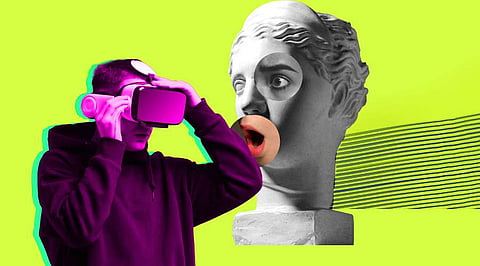

Integrating computer vision into augmented reality (AR) and virtual reality (VR) is revolutionizing how we perceive and interact with digital content. By equipping these technologies with the ability to "see" and comprehend the surrounding world, computer vision is crucial in creating immersive experiences that flawlessly blend the physical and digital domains.
The rapid advancement of technology has opened up new possibilities for developing immersive digital experiences. Among the most captivating breakthroughs are AR and VR technologies, which have the potential to transform how we interact with digital content and information. At the heart of these technologies lies the field of computer vision, focused on enabling computers to understand visual data and interpret the real world. As a result, integrating computer vision in AR and VR is essential for crafting captivating and immersive experiences that seamlessly merge the physical and digital realms.
One of the key aspects of computer vision in AR and VR is object detection. Using computer vision algorithms, AR and VR systems can identify and detect real-world objects, allowing virtual content to be integrated into them. This process involves capturing images or videos of the user's environment using cameras, which are then analyzed in real-time. Techniques such as edge detection, pattern recognition, and machine learning are employed to recognize objects based on their visual features, such as size, shape, and color. Once an object is identified, AR systems can superimpose virtual content on top of it, such as 3D models, animations, or text containing relevant information. This seamless integration of virtual content with the real world creates realistic and immersive AR experiences.
Another significant contribution of computer vision to AR and VR is gaze tracking or eye tracking. Gaze tracking allows VR systems to track the user's eye movements and adjust the virtual environment accordingly. By analyzing images or videos of the user's eyes captured by cameras within the VR headset, computer vision algorithms can detect and track the position of the user's pupils as they explore the virtual environment. This information is used to adjust the image based on the user's gaze, creating an illusion of depth and making the user feel present in the virtual environment. Gaze tracking enhances the naturalness and intuitiveness of the VR experience, enabling users to interact with the virtual world using their eyes.
Computer vision in AR and VR systems also improves spatial mapping and tracking. Computer vision algorithms help digitally represent the user's physical environment, mapping surfaces, objects, and boundaries. This accurate understanding of the physical space enables virtual objects to be placed realistically within the environment, resulting in seamless integration between the real and virtual worlds. Additionally, computer vision assists in tracking the user's movements, allowing the virtual content to adapt and respond to their position and gestures. This capability enhances the immersion and interactivity of the AR and VR experience, making it more intuitive and engaging for users.
Gesture recognition is another crucial aspect of AR, and VR experiences, and computer vision plays a significant role in enabling this functionality. By analyzing hand and body movements captured by cameras or depth sensors, computer vision algorithms interpret gestures and trigger specific actions or interactions within the virtual environment. Recognizing gestures such as pointing, grabbing, or swiping, the system provides users with a more intuitive and engaging user interface, enhancing their sense of presence and control in the virtual environment.
Real-time image processing is a critical component of AR and VR systems, and computer vision algorithms excel in this area. These algorithms perform real-time tasks such as image stabilization, noise reduction, and image enhancement. By improving the quality and stability of the captured visuals, computer vision ensures users a smoother and more visually appealing experience. In AR applications, where virtual content must be seamlessly integrated with the real-world environment, real-time image processing is crucial to avoid visual inconsistencies or artifacts.
Furthermore, computer vision enables object recognition and tracking in AR and VR systems. By analyzing visual cues and patterns, computer vision algorithms can identify and track objects in the environment. This capability allows virtual content to interact and respond to specific real-world objects, opening up possibilities for applications such as product visualization, educational simulations, and guided experiences. The ability of virtual elements to interact with and respond to physical objects in real-time enhances the overall user experience and provides contextually relevant information.
Join our WhatsApp Channel to get the latest news, exclusives and videos on WhatsApp
_____________
Disclaimer: Analytics Insight does not provide financial advice or guidance on cryptocurrencies and stocks. Also note that the cryptocurrencies mentioned/listed on the website could potentially be scams, i.e. designed to induce you to invest financial resources that may be lost forever and not be recoverable once investments are made. This article is provided for informational purposes and does not constitute investment advice. You are responsible for conducting your own research (DYOR) before making any investments. Read more about the financial risks involved here.
